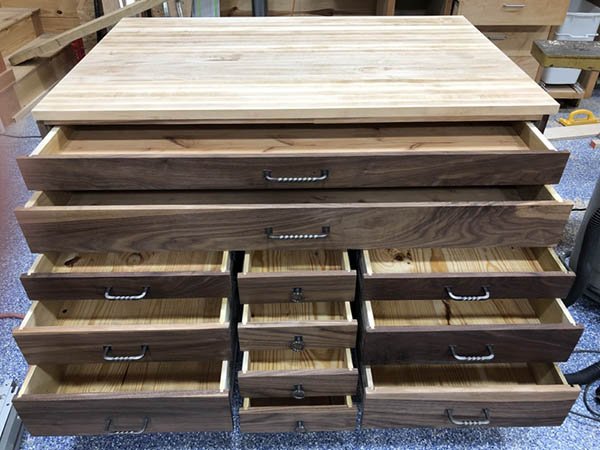
In the last issue, Rob asked “what size stuff are you making?” as he wondered whether large or small projects were most in favor. The answer, for some of you was “both.” – Editor
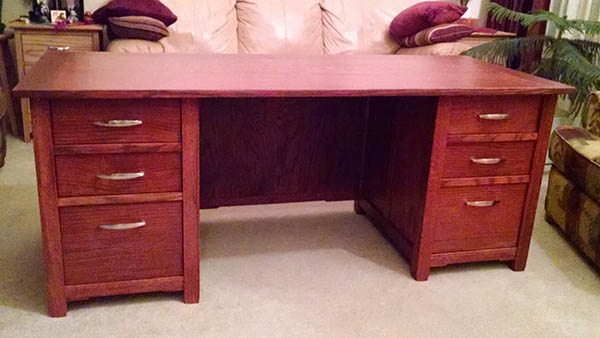
“Constantly flipping between the large and the small. Whether it be the large (I’ve done a desk and a buffet in the past couple of years) to the small (pens, toys, bowls), changing things up helps to keep my skills in practice and doesn’t lock me into one style of woodworking. I’ve attached a picture of a desk I made for my son. The top is 30-in. by 70-in. made of solid quartersawn red oak. The drawer cabinets are a mix of plywood and solid quartersawn red oak with the drawers Baltic birch with quartersawn red oak fronts on full extension slides. The finish is water-based black cherry stain with three coats of General Finishes satin polyurethane (sprayed). The desk disassembles into four parts: top, drawer cases (two) and modesty panel. The plans were for Greene and Greene, but I left out the button elements.” – Ken Weiss
“Big and small. That’s the name of the game. I never know what requests I will get, and if I am going to be successful I have to adapt. If a project is WAY too large for me to handle, I will decline the project, but that rarely happens. Like any business, I have to be flexible, and I really enjoy the challenge.” – Paul Michalski
“I recently completed remodeling the kitchen. All new shop-made base and upper cabinets, a couple custom cabinets for skillets and plastic bowls and lids and a large L-shaped island with seating for six. It involved re-routing plumbing and electrical connections, a new floor, paint and recessed lighting. It took a year to finish. The end result is really good, but I vowed never to do a remodel of that scope again. So, to relax, the following month I started building a vanity dressing table for my wife. It ended up over five feet wide, several drawers, three mirrors, vintage floral inlays, etc., etc. It’s all rock maple, just to make it more difficult. It turned out beautiful. But I am taking a rest. Currently, I am making Christmas presents for the family. Much smaller/I can fit 20 of them on my bench. Feels great to be in the shop without busting my rear end. Thanks for the opportunity to share.” – Rich Franks
“Your ‘The Large and Small of It’ article hearkened me back to my days as a young maintenance man, before I had a true love for woodworking and was more into just basic, ugly, functional projects. I was working with an older guy, who had very limited English skills but was very fluent in the language of being a handyman. We had to build these very large shelf units/bookcases in an enormous room in a hospital setting. I had no clue the scale of it, until we were building and building, etc., etc. You get the idea. Three days later, we had a humongous wall unit taller than us and 30 feet long, or so. I was impressed with our work. I asked him if it was the biggest thing he had ever built. He replied with a smile, ‘No, i built a five-story apartment building in the Philippines.’ I was astounded. It began a close friendship with a guy I already learned from and admired. Since then, I have built mostly tables, bookcases and, more recently, jewelry boxes and such. I find the smaller projects to be most challenging. In summary, regardless of the size of the projects I build, the satisfaction of finishing any size project is most rewarding.” – Tom Sherry
“I vacillate from ‘big’ pieces back to smaller ones. Recently, I built a six-foot-high corner cabinet with lighting inside, under the shelves for a collection of old memorabilia (i.e., cameras). I routed out channels in the underside of the shelves and put LED strips in them (like folks use under cabinets). I was ‘voted down’ on using colored LEDs – -haha, but it helps show off the things in the shelves. Then, My youngest daughter called with the usual ‘request’: ‘Oh, Dad, I need…’ In this case, she wanted three low-level kitchen type cabinets for her apartment at a lower height to match her roommate’s sideboards. Having never made cabinets, I found a really useful website (Down to Earth Woodworking), where the fellow showed in nice steps how to make a cabinet. I adjusted for the height my daughter requested, and instead of the usual thin wood found in kitchen cabinets, made them from 3/4 maple since she will someday take them apart from each other and move. I made doors, face frames, etc. and a simple wood top for painting. As a new member of the St. Louis woodworking guild, I am now spending time making wooden toys for their toy program. So, as you see, projects go from big to small, and find I can now make really good use of the scraps I save — the kind too small to save, too big to toss! Thanks for all the info you provide; I always find something useful!” – Paul Bailey, St. Louis, MO
Some of you take that “go big” saying to heart. – Editor
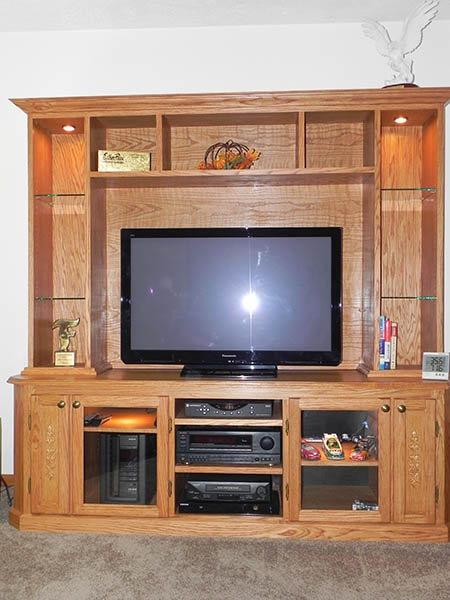
“While I still enjoy the small projects, it is the big ones that give the me more satisfaction. Obviously, they can be more impressive, like my personal entertainment center or an office hutch built around an existing vintage desk.” Ernie Mascarello

“I have built literally every piece of furniture in my home. The last big project was a new dresser for myself. Let’s just say it’s very helpful to have two big strong sons to carry it two floors up from my shop in the basement to the bedroom. Had to feed them as payment.” – Rudy Gonzalez
“Largest was an entertainment center in the late ’80s. Two-plus sheets of 3/4 ply, glass doors, solid wood drawers to hold the 32-in. TV, LPs, etc. Glad those days are behind us.” – John Kulluk
“For a long time, I was just making smaller projects since I had made all the wood furniture for our house, bed and dressers for nieces and nephews. I was kind of lamenting this, but then, my niece got married and my brother finally bought a house, so now I’m making a dresser to match my niece’s, a bookcase to match my brother’s desk set and a couple of window seats.” – Douglas Heckler
“Responding to your blog about large and small projects. I’m currently working on an island countertop that is 76-in. long by 65-in. wide and 2-in. thick, made from clear hickory, walnut and purpleheart. Boards were ripped into 2-in. wide boards and face glued back to together to form the countertop. It weighs in at about 400 pounds. Need three people to move it safely.” – Don Thomson
“A number of years ago, I built a large armoire for the master bedroom. It was 6 feet long, 7 feet 20-in. tall and 2 feet 3-in. deep. I made it in three pieces as it needed to make a left turn to get into the room. The bottom piece was the chest of drawers section with three banks of three drawers. Since it was only 29-in. tall, I was able to move it into the room by setting it up on one end. Same story for the top storage unit. The trouble came when I tried to get the clothes hanging section through the door. It was 4 feet 2-in. tall and the hall was only 3 feet wide. It just wouldn’t go around the corner! I had to disassemble it to get it in and then reassemble it in place. I think of just including it when we sell the place and let the new owners figure out what they want to do with it. Now that I am remodeling an old house, I’m planning ahead and getting any large furniture into the second floor before I build the new floor for the second floor laundry room. Lesson learned (I hope). Still need to figure a way to get the 1908 clawfoot tub up to the master bathroom without needing a crane!” – J. Eric Pennestri
“It isn’t the largest or the heaviest piece I’ve built, but it might be the densest. A few months ago, I finished up on a subwoofer cabinet for my TV room. It is 28-in. wide x 24-in. deep x 72-in. high, and weighs 350 pounds and is made of 1-in. Medex. Because of the weight, I made it so it can be broken down into three pieces: top half, bottom half and the back. My wife is absolutely no good with moving heavy stuff, so to lift and maneuver the assembled parts, I used a small electric winch and a pulley in the ceiling. That worked very well; it has lots of power and a variable speed trigger so it can lift in very small increments. When it was done, I used the winch to load the parts onto a furniture dolly to move it into the basement. Building something big and heavy certainly requires that you add another dimension to the planning and execution of the project. Oh, and the project was a thunderous success. With an 18-in., 1000W RMS driver, it rocks the room and, indeed, the whole house. We do not have it turned up loud past 9:00 PM out of consideration for the neighbors.” – Frank Pratt

“I have made some large wood projects in my day: dining room tables, outside benches and a hutch, to mention a few. But the biggest was a bunk bed for my two boy grandchildren. It took about five months. I built it in my basement and dry fitted it so I could reassemble it at my daughter’s house but still needed help to move some of the subassemblies. I took the design from a bed manufacturer, made some enhancements, drew up the plans, and added some other features: drawers in the steps, lights in the lower section and up the steps, etc. It was, by far, the most challenging piece I built so far. Loved every minute of the process.” – Bill Cafero
“My biggest pieces are hope chests for my sons as wedding presents, cradles for their babies and a big old six-foot-tall bookcase for my Civil War library. Funny story about the bookcase: my wife and I were checking out an antique shop when we came upon a bookcase we absolutely loved … until we saw the price. I went to the shop owner and told him we were interested in the bookcase, but was not sure if it would fit where we wanted to put it. I asked if he had a tape measure, which he gave me, and I proceeded to take all of the measurements of the bookcase, which my wife wrote down. When we got home, I made an almost exact duplicate, using the measurements. And, yes, I needed a neighbor to help me move it from the workshop to my ‘reading room.’ I love getting the online version of the Journal. Thank you.” – George Dehaven
“I just finished a five-foot-tall bookcase with through tenons on the shelves, all by hand. I’m now working on its twin.” – Peter Fabri
While for some, it’s the little things – sometimes, for practical reasons. – Editor

“Like you, I seldom build large stuff except by request from the family mostly. It just takes up all the space in my shop to do it. I typically work on several small projects at the same time. This lets me work on one while the finish or glue is drying on another. It also keeps me interested. With a large project, all my space and resources are used up on the one project and I just have to wait until that portion of it is done before I can do anything else. I don’t mind doing them, it just limits my woodworking time. I mostly build stringed instruments, frames, display cases and small boxes. The big projects are fun once in a while, but I don’t make a habit of it.” – Chuck Chall
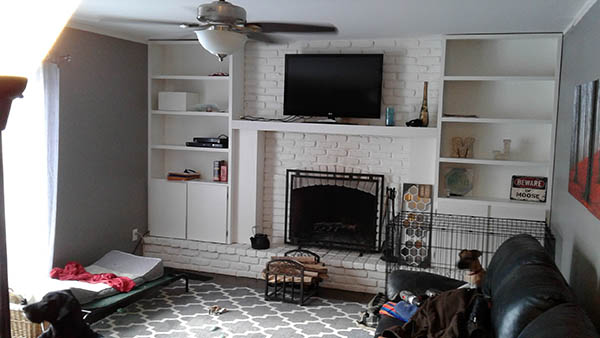
“My projects are much smaller now than a few years ago. Managing large sheet goods is not good company for my back these days. That’s OK, I just take more time with the smaller pieces I construct so the pride is saved through finer details.” – T. Newman
“Although I never made big projects before, I am now of the age where I hardly can lift the plywood sheets or the heavy 8/4 hardwood lumber. I now insist on making small projects. If I can’t lift the lumber for the project, I don’t make it.” – Marcel Corbeil
“First: Thanks for your useful and always interesting newsletters. Having built the hutch for the kitchen, headboards in the bedrooms, numerous end tables, desks, blanket chests, bookcases, jewelry boxes, toys and dollhouses and cradles and benches for the kids over the last 60 years (now 86), I’m now puzzling over what to do with all those beautiful small leftover pieces of wood. Every niece and nephew has one of my pencil boxes, bookends or writing desks. No more room on the walls for picture frames or shelves. Guess it will all end up as kindling next winter.” – Bob Weber
“Reading your article this week on project size got me thinking, especially since I recently finished building a full-sized desk, that I would like to build smaller projects, particularly as Christmas gifts to send relatives who live out of town, but somehow I feel drawn to larger projects like dressers and cabinets. Maybe it’s just because I can’t find anything I think they’ll like, or maybe it’s because I just find large pieces more impressive. Either way, building large pieces is pretty stressful on the budget, so it may get to the point that if I don’t concentrate on smaller pieces I won’t be able to create anything.” – Rob Billeaud
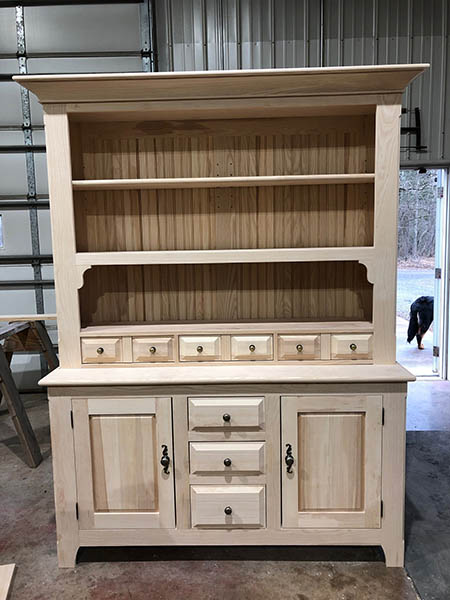
“I’m 66 now and the hutch may be the last big piece. Unless, of course, one of my daughters wants something.” – Tom Hinaman
And some readers just wanted to share what they’re currently building. – Editor

“Fits your categories of desk and need help to move. Made of pine with walnut trim/accents. Just finished yesterday.” – Paul Saladin
“I’m running out of space in my house to put new projects so I’m currently working on a rolltop cabinet for my daughter. New router bits, new material (cherry) and a new challenge (building the rolltop) add up to a fun spring project.” – Earl Slack
“In response to your question concerning what big project am I working on, I have designed a 6-gun cabinet using SketchUp based on a cabinet style copied from wall-to-wall cabinets and bookcase that my neighbor brought back from Germany when he retired from the Air Force. It is very unique, a style I have never seen before. I started construction on April 28 using walnut harvested years ago from an ice storm on my farm.” – Dannie Musser
“Just recently started making cutting boards and serving trays (my current project). I am going to be building for the fall craft shows.” – Jerry Price
“I’m responding to your note on your blog about current projects. Like you, I’m currently completing a desk, but this one is intended for my grandson. I’m working with African mahogany for the first time. It’s a beautiful wood. I plan on staining it today and will send you a picture when it’s complete. I’ll be adding a detachable hutch as the final step. I appreciate your wisdom and insights.” – Sim Galazka

“My current project.” – David Harris
“Been a long-time reader of your publication. Love it. My project is actually a series of projects which, over time, will make up a columbarium situated within a room in our church in southeast Texas. I have built the support structure, which I will install in the coming weeks. Once the burial urn structure is in place, I will start the process of finishing it with black cherry. Additionally, I will be building three large 4 x 4 foot frames in which three large pieces of stained glass windows will be housed. The backs of these frames will house a lightbox whose purpose will be to backlight the stained glass. This will likely be my last really big project, although I have s slab of mango that wants to be a waterfall coffee table. Again, thanks for the Woodworker’s Journal, I have been reading it since 1982.” – Steve Tibbetts
“Platform bed frame for the master bedroom. The kind with drawers underneath. Prepping for purchase of a new king size mattress. The one absolute proviso is no big frame members sticking out to catch the queen’s shins.” – Steve Dragg
“I’m just about to start on a bedroom set to replace the one we bought when my wife and I got hitched in 1976. I think it’s about time. Two dressers, two night tables, headboard, footboard and drawers beneath the mattress to replace the box spring for extra storage. All in solid cherry. This will be my first major project using Kreg pocket hole joinery wherever it won’t be seen. The design is probably going to take as long as the build if I don’t start getting faster with the drawings! But, with the cost of cherry, I gotta do it right the first time!” – Jim Merzetti

“You’re ‘what are you building’ question is pretty timely for me as I have just finished a bench on wheels with yellow box storage. As they say, a picture is worth a thousand words so, without further delay: I built a 1.25-in. edge grain maple top for it. And, in my very best TV infomercial voice: But wait, it’s double-sided. It’s about 37-in. by 57-in. with the top two drawers about 55-in. wide. All drawers are on slides. I used walnut fronts for the drawers on this side. To protect that top, I took two sheets of 1/8-in. hardboard, glued them together and cut it down to the size of the top. Then I sunk a magnet washer into the four corners of the top and embedded 3/4-in. rare-earth magnets into the same spots on the sheet of hardboard so that the cover ‘snaps’ into place when slid onto the top. As a secondary measure of protection, I added a box on one end to hold rolls of kraft paper which can simply be pulled over the top. Good luck on your desk!” – Mark Danner
